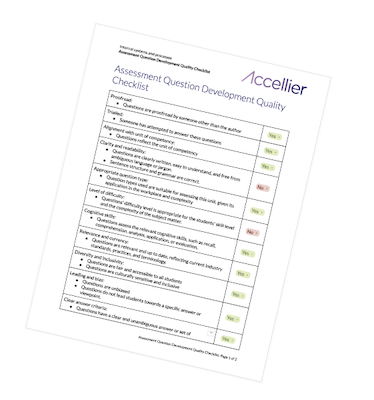Questions play a crucial role in confirming knowledge, checking learning has taken place, and they serve as a learning tool.
Creating effective assessment questions involves understanding various question types, using Bloom’s Taxonomy, and adhering to specific guidelines. In this article, we’ll explore how to develop effective assessment questions.
Slide show and webinar recording
This article comes from our recent webinar (slide deck available here)
Question Types
There are several question types, each with a specific utility, including multiple-choice, true or false, short-answer, essay, fill-in-the-blank (Cloze), matching, ranking, hotspot, drag/drop, case studies and scenarios, practical or performance-based tasks, and oral questions.
Each question type tests different aspects of a student’s knowledge, comprehension, and application of concepts. Understanding the purpose of each question type will help you create effective assessment questions that align with the learning objectives.
Examples of Good and Poor Questions
In the webinar recording (at around 13m 30seconds) you will see we explore some examples of good and poor questions.
A good question is concise, clear, focused, and uses appropriate terminology. It should address key concepts and be relevant to real-world situations. On the other hand, a poorly worded question can be vague, informal, and confusing. Poor questions may also be trivial, subjective, ambiguous, or have spelling and grammar errors.
When developing questions from units of competency, avoid simply adding “how would you…” or “what are the…” to the performance criteria and knowledge evidence. Instead, consider the application of knowledge and create questions that follow performance, using the provided examples as guidance.
Is there a Formula for writing Assessment Questions?
There are many ways to create a good assessment question, and the sentence structure can vary. Though having a formula can be useful to help consider they key parts of a good question.
Here’s a formula which may help you structuring questions:
[Question word/phrase] + [subject] + [action/context] + [specific detail/focus] + [clarifying information]
Here’s how it works:
- Question word/phrase: E.g., What, Which, How, Describe, Explain, Compare. This Sets tone and clarifies the type of response expected.
- Subject or topic the question relates to.
- Action or context that students need to address, analyse, or apply in their response (e.g., identify, evaluate, discuss, demonstrate, solve).
- Specific detail or focus. Narrows the scope of the question and defines what aspect of the subject students should concentrate on.
- Clarifying information: E.g. examples, constraints, or other relevant details.
When applied in an example it might look like this:
“Explain how [question phrasing] the process of photosynthesis [subject] converts light energy into chemical energy [action or context] in plants, [specific detail or focus] focusing on the roles of chlorophyll and cellular organelles [clarifying information].”
Applying Bloom’s Taxonomy
Bloom’s Taxonomy is a hierarchical classification of cognitive skills that can help in creating assessment questions. The six levels are:
- Remembering: Recall facts and terms.
- Understanding: Explain ideas or concepts
- Applying: Use knowledge and understanding to solve problems.
- Analysing: Break information down into parts.
- Evaluating: Assess the value or quality of information.
- Creating: Generate new ideas, products, or ways of viewing things.
Use the verbs in the performance criteria to guide the creation of questions that target different levels of Bloom’s Taxonomy.
5 tips for Developing Assessment Questions
- Be mindful of the unit of competency wording, especially the verbs
- Try creating shorter, themed quizzes, rather than one long ‘exam’
- Develop questions that follow-up tasks, including reflective questions. Asking how and why a student did something, is more powerful than asking them how they might do something in theory, before they’ve actually done it.
- Try interview and discussion questions
- Create comprehensive scenarios, then attach a range of questions to that scenario, including alternatives and ‘what ifs’.
Free Assessment Question Review Checklist

Do you want a free checklist you can use to review your assessment questions before you use them to assess students?
You can either download this as a Word Document (DOCX) or if you use Google Workspace Docs, simply go here then ‘File > Make a Copy’.
Case Studies
Accellier Success Stories
Celebrating the success of the E-Learning Facilitator Micro-credential (TAEDEL501)
Learn more about our TAEDEL501 Facilitate E-Learning Micro-credential.
Accellier Graduate Story: Marion
Marion, a successful Accellier Certificate IV in Training and Assessment graduate tells her story.
Qualified visual arts trainer videoAccellier goes on night-duty to upgrade Steggles/Baiada TAE qualifications
One of the managers John Morriss added that one of the best aspects of the course was the use of real life examples that were relevant to his industry and role.
Baiada Poultry